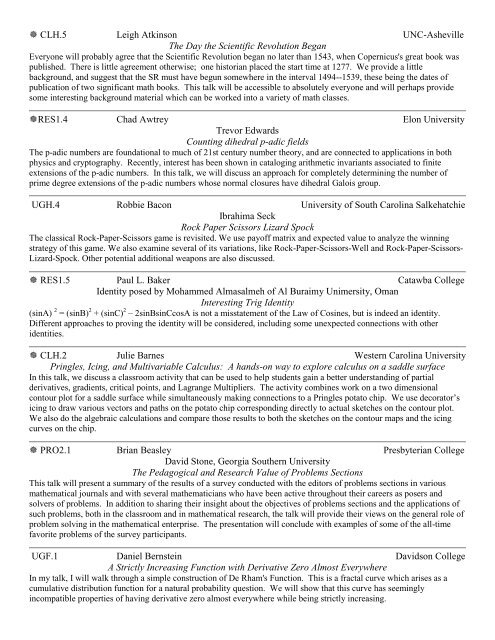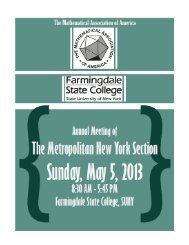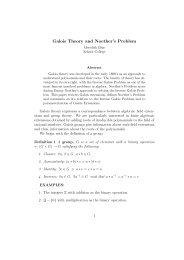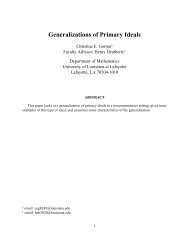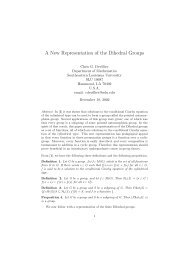Presentation Abstracts - MAA Sections
Presentation Abstracts - MAA Sections
Presentation Abstracts - MAA Sections
You also want an ePaper? Increase the reach of your titles
YUMPU automatically turns print PDFs into web optimized ePapers that Google loves.
CLH.5 Leigh Atkinson UNC-Asheville<br />
The Day the Scientific Revolution Began<br />
Everyone will probably agree that the Scientific Revolution began no later than 1543, when Copernicus's great book was<br />
published. There is little agreement otherwise; one historian placed the start time at 1277. We provide a little<br />
background, and suggest that the SR must have begun somewhere in the interval 1494--1539, these being the dates of<br />
publication of two significant math books. This talk will be accessible to absolutely everyone and will perhaps provide<br />
some interesting background material which can be worked into a variety of math classes.<br />
RES1.4 Chad Awtrey Elon University<br />
Trevor Edwards<br />
Counting dihedral p-adic fields<br />
The p-adic numbers are foundational to much of 21st century number theory, and are connected to applications in both<br />
physics and cryptography. Recently, interest has been shown in cataloging arithmetic invariants associated to finite<br />
extensions of the p-adic numbers. In this talk, we will discuss an approach for completely determining the number of<br />
prime degree extensions of the p-adic numbers whose normal closures have dihedral Galois group.<br />
UGH.4 Robbie Bacon University of South Carolina Salkehatchie<br />
Ibrahima Seck<br />
Rock Paper Scissors Lizard Spock<br />
The classical Rock-Paper-Scissors game is revisited. We use payoff matrix and expected value to analyze the winning<br />
strategy of this game. We also examine several of its variations, like Rock-Paper-Scissors-Well and Rock-Paper-Scissors-<br />
Lizard-Spock. Other potential additional weapons are also discussed.<br />
RES1.5 Paul L. Baker Catawba College<br />
Identity posed by Mohammed Almasalmeh of Al Buraimy Unimersity, Oman<br />
Interesting Trig Identity<br />
(sinA) 2 = (sinB) 2 + (sinC) 2 – 2sinBsinCcosA is not a misstatement of the Law of Cosines, but is indeed an identity.<br />
Different approaches to proving the identity will be considered, including some unexpected connections with other<br />
identities.<br />
CLH.2 Julie Barnes Western Carolina University<br />
Pringles, Icing, and Multivariable Calculus: A hands-on way to explore calculus on a saddle surface<br />
In this talk, we discuss a classroom activity that can be used to help students gain a better understanding of partial<br />
derivatives, gradients, critical points, and Lagrange Multipliers. The activity combines work on a two dimensional<br />
contour plot for a saddle surface while simultaneously making connections to a Pringles potato chip. We use decorator’s<br />
icing to draw various vectors and paths on the potato chip corresponding directly to actual sketches on the contour plot.<br />
We also do the algebraic calculations and compare those results to both the sketches on the contour maps and the icing<br />
curves on the chip.<br />
PRO2.1 Brian Beasley Presbyterian College<br />
David Stone, Georgia Southern University<br />
The Pedagogical and Research Value of Problems <strong>Sections</strong><br />
This talk will present a summary of the results of a survey conducted with the editors of problems sections in various<br />
mathematical journals and with several mathematicians who have been active throughout their careers as posers and<br />
solvers of problems. In addition to sharing their insight about the objectives of problems sections and the applications of<br />
such problems, both in the classroom and in mathematical research, the talk will provide their views on the general role of<br />
problem solving in the mathematical enterprise. The presentation will conclude with examples of some of the all-time<br />
favorite problems of the survey participants.<br />
UGF.1 Daniel Bernstein Davidson College<br />
A Strictly Increasing Function with Derivative Zero Almost Everywhere<br />
In my talk, I will walk through a simple construction of De Rham's Function. This is a fractal curve which arises as a<br />
cumulative distribution function for a natural probability question. We will show that this curve has seemingly<br />
incompatible properties of having derivative zero almost everywhere while being strictly increasing.


